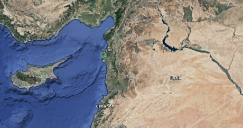Rockin’ in the Free World
See all the indents in this clay tablet? Those are cuneiform signs and written in the Hurrian language. Cuneiform signs were made by pressing a slightly pointed stylus into wet clay. This gave the signs their distinct wedge-shaped appearance.
The tablet was discovered in the 1950s, when a French archaeological mission discovered hymns written in Hurrian in the ruins of the royal palace of Ugarit (Fig 4).
Ugarit was a city-state located in modern Syria on the Mediterranean coast (Fig 5). Because of this central location, the town flourished in the Late Bronze Age (± 1550-1200 BCE). It was a period of increased interregional interaction. A network of trade and diplomacy existed between the states of Egypt, Babylonia, Hatti (in modern Turkey), and everything in between. Ugarit occupied a highly lucrative intersection between these Great Powers and as a result, it grew to be wealthy.
As a result of this, extensive administration was required and to that end a highly developed scribal culture. These professionals were required to read and write in a multitude of languages and scripts, which all came together in the cosmopolitan markets and the archives of Ugarit.
An important one of these languages was Akkadian, written in the cuneiform script. It was native to Mesopotamia but used as an international diplomatic language. However, texts written in Hittite, Egyptian, and Cypro-Minoan were also discovered at Ugarit. The most common local languages were Hurrian, spoken in northern Syria (and the main language of this tablet), and Ugaritic, which was exclusive to this city-state and made use of a uniquely developed alphabetic script, the first of its kind
It was in this melting pot of cultures and languages that a number of literary hymns were written down in Hurrian. Unfortunately, only no. 6 survived in full. The lyrics of the song on this tablet are in Hurrian, but the musical notation uses Akkadian, with terminology which has some significant Hurrian influences
](https://micrio.thingsthattalk.net/csjqI/views/max/171x128.jpg)
